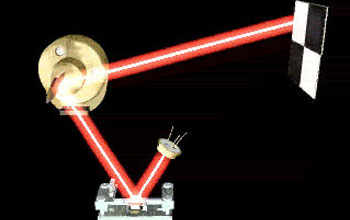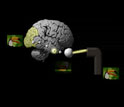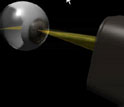|

Discovery
Virtual Display Beams Images Directly into the Eye

Researchers have developed a display that beams full-color images directly onto your retina.
June 3, 2004
Researchers at the Human Interface Lab of the University of Washington have developed a novel display system. The device beams images directly onto the human retina, in full color and at VGA resolution (640 x 480 pixels). Using a low power laser, the device scans line after line of an image directly onto the back of the eye at such a fast rate that the complete image refreshes 72 times per second, fast enough for a movie.
The team, led by Eric Seibel, is working to develop a 3D system that scans an image into both eyes resulting in high-resolution, full color, 3D displays.
The animations depict what the researchers believe a low-vision subject will see with their assistive device. The animations were created by Quinn Smithwick of the Human Interface Technology Laboratory.
-- Josh Chamot
Investigators
Eric Seibel
Related Institutions/Organizations
University of Washington
Locations
Washington
Related Programs
Engineering Design
Related Awards
#9703598 Optimization Studies for Applications of a Scanned Light Display
#9801294 SGER: Decision-Based Engineering Design for a Low Vision Aid Using the Virtual Retinal Display
Total Grants
$462,985
Related Websites
Eric Seibel's website: http://www.hitl.washington.edu/people/eseibel/
Human Interface Technology Laboratory: http://www.hitl.washington.edu/
Virtual Retinal display website: http://www.hitl.washington.edu/projects/vrd/
|





